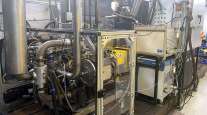Nat-Gas Truck Sales Get Serious With New Engine, Kenworth Says
This story appears in the July 22 print edition of Transport Topics.
CHILLICOTHE, Ohio — Natural gas-powered engines have moved beyond the “science project” stage and into the trucks-for-sale phase, and Kenworth Trucks executives said they believe they can sell every 12-liter Cummins Westport engine they can obtain.
Kenworth will be going into full production with the ISX12 G engine in early August at its 477,000-square-foot plant here. The company’s natural-gas offerings include three engine sizes — 15, 12 and 9 liters — in five truck models.
“All of our gas engine sales are up, year-over-year, but this new 12-liter model is the most significant difference,” said Andy Douglas, Kenworth’s national sales manager for specialty markets. Kenworth’s allotment from Cummins Westport for 12Gs is about 30 per week, he said.
From March to mid-July, the 12Gs were in limited production, and Kenworth installed about 75. The engine maker started with 350-horsepower models and is moving up to 400-hp versions, Douglas said, adding that natural-gas engines are far past the notion of theory.
“This is no longer a science project,” he said.
Kenworth, a division of Paccar Inc., hosted editors at a ride-and-drive event July 12 following its annual natural-gas summit for 100 dealers and customers.
The 12Gs are available on Kenworth’s T660, T800 and W900 tractors, and most of that work will be done here. The original equipment manufacturer also puts Westport Innovations’ 15-liter, high-pressure, direct-injection engines in T800s, but that is done at the manufacturer’s plant in Renton, Wash.
The nearly 2,000 employees at the plant here have experience with Cummins Westport technology, as they have been installing ISL G 9-liter engines in W900s, T440s and T470s, plant manager Scott Blue said.
Cummins Westport Inc. is a joint venture between engine maker Cummins Inc. and fuel system and engine manufacturer Westport Innovations.
Kenworth’s current customer base for natural-gas trucks includes UPS Inc., the Express and Freight divisions of FedEx Corp., C.R. England Inc., Coca-Cola Co., Land O’Lakes Inc. and Trimac Transportation, Douglas said.
In terms of manufacturing, Blue said the main difference between diesel and natural-gas trucks is that the nat-gas models leave his plant with temporary “pony tanks” rather than permanent vessels for compressed or liquefied natural gas. Permanent tanks, as selected by customers, are installed by upfitters at off-site locations.
Kenworth provided a fleet of 10 trucks for reporters to sample. Six had CNG or LNG engines and the rest had conventional diesel power plants. Drivers took journalists on tours of central Ohio roads through vast corn and soy fields interrupted by factories belonging to DuPont, PPG Industries and Georgia-Pacific Corp.
Company officials touted the quieter ride of the natural-gas models as they shuttled reporters around during the test rides.
Douglas said a Cummins engine brake is available with the 12Gs, but they are not as robust as engine brakes on a traditional diesel power plant. Engine brakes are driven by compression within the cylinders, and diesels develop much more of that than do their nat-gas counterparts.
As the 12G burns pure natural gas with the help of sparkplugs, the truck needs neither a diesel particulate filter nor selective catalytic reduction.
For traveling in the western United States, where crossing the Rocky Mountains is commonplace, Douglas suggested a T800 with the Westport HPDI engine. UPS uses these on routes running from Los Angeles to Las Vegas and on to Salt Lake City.
Kenworth makes HPDI trucks with LNG fuel tanks, whereas the 12G engines can use either CNG or LNG.
As for the ISL G, Kenworth said this could be used in either a small “baby 8” Class 8 application or in a Class 7 truck. It will be aimed at vocational use such as dump trucks and cement mixers or for local distribution.
The ISL G is an older technology, allowing time for more software adjustment.




